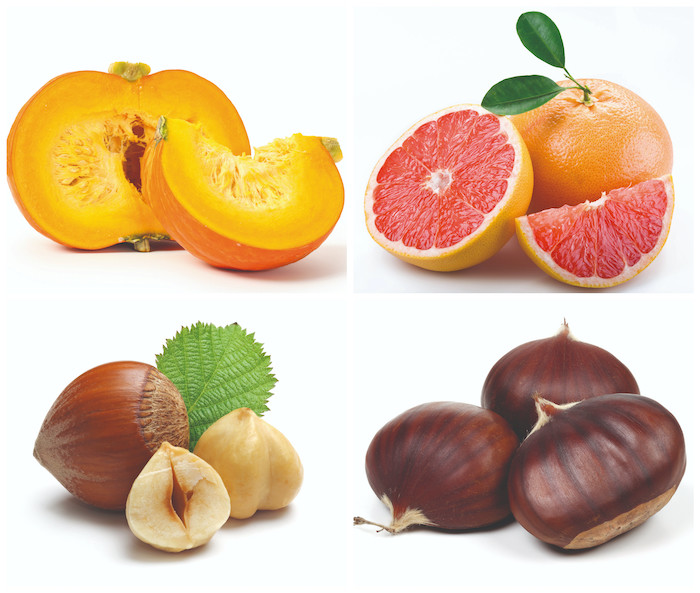
Anistatia Miller and Jared Brown make their pick of the seasonal crops for enhancing drinks.
Pumpkin
The annual spiced pumpkin trend has returned. It’s an invasion, originating in the US where pumpkin was an annual autumnal flavour tradition even before the first Brits arrived. But what is this now-ubiquitous taste of the season? It’s cinnamon, nutmeg, ginger and cloves. Allspice and cardamom are optional. And so is the pumpkin.
Apples
Swap apples for pumpkin (they’re piling up under every apple tree in Britain), and you have the structure for a much older and more traditional drink – wassail. We press a lot of cloudy apple juice from the garden every year. Naturally – sometimes too naturally – some of it turns to cider. But some also become a liqueur sweetened with a syrup of the above-mentioned spices, fortified with rum or gin or brandy, and so much better than that American latte.
Hazelnuts
Shortly after the Covid-19 lockdowns ended, we took a few visiting bartenders to the Green Bar at the Café Royal in London. The waiter sat us at a table (we adore their Danish modern chairs). He gave the bartenders menus, then glanced at us and said: “Your usual?”
We said yes, dying to discover what our usual had been and overjoyed when it turned out to be the Army & Navy. Such a simple structure: gin, fresh lemon and orgeat. Though it is virtually unknown compared to the Bee’s Knees or Gimlet, it certainly shares their ranking in flavour.
Hazel trees grow all over Britain, a vestige of a time when there were far more thatched roofs, requiring bent hazel spars– basically giant hairpins to hold the thatch in place. Right now, there’s a glut of hazelnuts, cobnuts and filberts (cobnuts are cultivated wild hazelnuts, filberts are a subspecies of hazelnuts). And all make a stunning replacement for the almonds in orgeat.
Orgeat is actually fairly simple to make. Hazelnut orgeat equally so. Toast the hazelnuts in a hot skillet to bring out their best flavours. Then, we chuck them in a Lewis bag and beat them with an ice mallet (a rolling pin works well, too). After that, throw them into a blender. Many people blend them without liquid, but we’ve found that it goes more smoothly to add simple syrup rather than combining them afterwards. The other fundamental ingredient, of course, is orange flower water. We also add a pinch of salt. In the next few years, a touch of saline will become as common in drinks as citrus. It’s taken bartenders a long time to discover that salt improves nearly all drinks. Now that it’s happened, there’s no going back.
Chestnuts
Another British nut begging to become orgeat is the chestnut. Same measures and methods. If you want to get truly carried away, find a place where you can roast them over an open fire to introduce a touch of smoke and caramelisation that doesn’t happen on a stovetop. One confession: We don’t keep many homemade syrups around the house. They’re never shelf stable and tend to ferment, so we add spirits, turn them into liqueurs, and considerably extend their shelf life. Our latest chestnut orgeat got along very well with grappa as a base.
Pink grapefruits
Pink grapefruits are piling up in the shops, both because they’re in high season and because doctors have recently told 35% of Brits aged 30-84 (nearly 100% of men over 60 and women over 75) that they cannot consume grapefruit in any form as it causes problems when taking statins – blood thinners. While the Paloma is experiencing a boom among young drinkers, grapefruit juice sales in the UK have dropped by half since 2021. That said, grapefruit and cardamom bitters are dead simple and wildly good on a Ramos Gin Fizz and also in drinks that aren’t a pain in the butt – or the elbow– to make. Place the peel of a pink grapefruit and half a dozen lightly crushed cardamom pods into a small jar of brandy and leave it overnight. You can leave it for a couple days if you like, but try it after 24 hours and you may find it’s already just where you want it.
There’s so much more to discover and to make in this season of abundance as we prepare for those last few months of the year – the time of celebrations when customers party non-stop and bartenders dream of time off in January.
Seasonal ingredients
Domestic
Apples (Sep/Oct/Nov)
Bilberries (Sep)
Blackberries (Sep)
Blueberries (Sep)
Bramley apples (Sep)
Chestnuts (Sep/Oct/Nov)
Chives (Sep/Oct)
Cobnuts (Sep/Oct/Nov)
Coriander (Sep)
Crab apples (Sep)
Damsons (Sep/Oct)
Elderberries (Sep/Oct)
Figs (Sep/Oct)
Melons (Sep/Oct)
Mint (Sep)
Oregano (Sep)
Pears (Sep/Oct/Nov)
Plums (Sep)
Quince (Oct/Nov)
Raspberries (Sep)
Redcurrants (Sep)
Rosemary (Sep/Oct/Nov)
Sage (Sep/Oct/Nov)
Sorrel (Sep/Oct)
Thyme (Sep/Oct)
Imported
Bananas (Nov)
Mandarins (Sep/Oct)
Mangoes (Oct/Nov)
Persimmons (Oct/Nov)
Pineapples (Sep/Oct/Nov)
Pink grapefruits (Sep/Oct/Nov)
Pomegranates (Sep/Oct/Nov)
Satsumas (Oct/Nov)
Yuzu (Nov)


